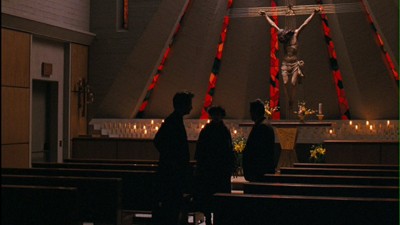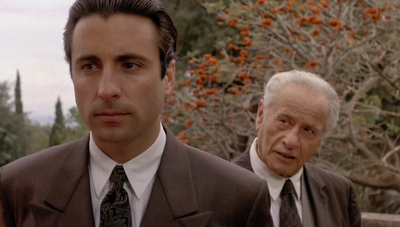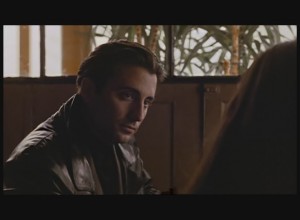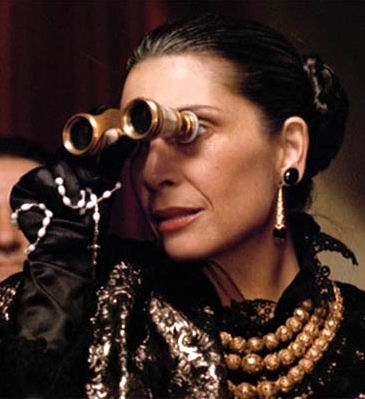From the Chicago Reader (January 18, 1991). — J.R.

THE GODFATHER PART III
*** (A must-see)
Directed By Francis Ford Coppola
Written by Mario Puzo and Coppola
With Al Pacino, Andy Garcia, Sofia Coppola, Eli Wallach, Talia Shire, Diane Keaton, and Joe Mantegna.
Let’s agree from the outset that the conclusion of the Godfather trilogy is not giving audiences everything that they expected based on the two previous installments. Shorter at 160 minutes than either of the first two parts, it proceeds in fits and starts, without the sustained narrative sweep of the first or the comprehensive historical spread of the second. Overall, there is less of a continuous story line (and less lucidity, coherence, and conviction regarding what plot there is), less violence, and less dramatic conflict; the quality of the performances is more variable; the settings are less memorable. There are even moments of risible implausibility. (Suffering insulin shock while visiting Cardinal Lamberto in a garden, Michael Corleone requests something sweet, and a pitcher of orange juice appears within seconds; and the virtuoso climactic sequence at the opera ultimately strains credibility by drawing together too many events at once.)
But conceptually and morally, one can argue that The Godfather Part III is superior to the two films in the Corleone family saga that preceded it. If it’s a failure, it’s a failure of a particularly noble kind.
Both earlier parts are grand entertainments predicated for the most part on two conflicting emotions — a savoring of violence, crime, and duplicity and remorse about the same three things. These attitudes are played off against each other not as a dialectic but as two possible ways of responding to the material, a contradiction that Coppola’s style exalts to epic proportions. It’s a method that can be traced all the way back to the script Coppola coauthored for Patton (1970), a film that allows one to feel either respectfully awed or simply appalled by its title character — or both things in tandem. The same sort of double-dealing can be discerned in other ambitious Coppola films as well — Apocalypse Now, which managed to pitch its passionate arguments about the U.S. military presence in Vietnam to hawks as well as doves, catering to the biases of both factions without alienating many people on either side (a sleight of hand that probably deserved a special Oscar all its own), and The Conversation, a thriller about surveillance that successfully made its audience feel simultaneously complicitous, guilty, and morally disapproving about the hero’s snooping.
All of these films are undeniably powerful, even in their overreaching, but part of what makes them so dramatically effective is their capacity to wallow in their own ambivalence and persuade us to wallow along with them. Enhancing this process is a notion they present of America itself as a morally ambiguous entity — dark and monumental, brooding and bloody, exalted and tainted — which makes these films seem like even larger and more ambitious statements about their respective subjects. By glamorizing both moral offenses and the guilt that follows them, these movies encourage us to feel narcissistic at the same time that they qualify as genuine moral inquiries. Considering the degree of breast-beating, soul-searching, and teeth gnashing in these movies — which is what they exhibit, encourage, and, in the final analysis, glorify — they’re epics tailor-made for the most blinkered and self-righteous among us. (Is it any wonder that Patton is Richard Nixon’s favorite movie?)
Even more guilt is present in The Godfather Part III than in its two predecessors, but this time it is merely acknowledged, not celebrated, and the crimes that occasion it are only memories — crimes that are recalled and discussed but not recapitulated in flashbacks. Emotionally speaking, these crimes boil down to one above all — Michael Corleone (Al Pacino) having ordered his own brother Fredo (John Cazale) killed for participating in a plot against him near the end of part two. In most respects the new film is devoted to playing out the full implications of that remembered act.
Part three, set in 1979-’80 (and featuring some fanciful anachronisms in relation to the death of Pope Paul VI), has its own eruptions of violence, but none of them is directly instigated by Michael. More important, with the exception of a few killings committed by Michael’s illegitimate nephew Vincent (Andy Garcia) — carried out partially in response to attempts on his own life — it doesn’t seem like the film is offering any of them as spectacles to be savored.
The first two parts charted the price of success — the moral cost of the Corleone family’s amassing its fortune and power through crimes and vendettas — while the third part documents a series of failures. There is the failure of Michael to erase or make up for his former sins, including the murder of Fredo, or to become legitimate through charity and new business investments. His former gambling and drug interests are now controlled by a thug named Joey Zasa, played with caustic brilliance by Joe Mantegna; the fact that Zasa is Vincent’s employer at the beginning of the film and goes to Michael for help in a dispute with the unruly nephew shows us at the outset that Michael’s break with his criminal past is less complete than he would like to imagine. Beyond that is the failure of America itself to maintain its dominance in the world market, a subtext of the film as a whole. Finally, there is Michael’s failure to protect and nurture his own family and to steer Vincent along a less violent path than his own; and because family itself remains the highest value in the Godfather saga — the ultimate justification for Michael’s past crimes — this crowning failure marks the trilogy as a whole as a tragedy.

Coppola has represented this tragedy in highly personal and even quasi-autobiographical terms. Theoretically, this is an approach that could have made the conclusion even more pretentious than its predecessors, but in fact it winds up doing the reverse. Because The Godfather Part III is conceived more in relation to Greek tragedy than in relation to the imponderables of Shakespearean melodrama, its scale is relatively life-size. (As a friend points out, the film is about the “fall of the House of Corleone.”) Shakespeare often suggests intimidating, heavy-duty culture; perhaps the relative simplicity and starkness of Greek tragedy and its relative unfamiliarity to contemporary movie audiences is what yields part three’s smaller scale.
To my mind, the single most impressive aspect of the new film is Pacino’s performance. In order to describe what makes it so different from his previous performances as Michael Corleone, it’s necessary to refer to Manny Farber’s 1962 essay “White Elephant Art vs. Termite Art.”

Farber’s essay, which deals with contemporary painting as well as movies, is a polemic against self- importance and monumentality, which he calls “white elephant art,” and for a less self-conscious and more low-key approach to creativity, which he calls “termite art”: “Movies have always been suspiciously addicted to termite-art tendencies. Good work usually arises where the creators (Laurel and Hardy, the team of Howard Hawks and William Faulkner operating on the first half of Raymond Chandler’s The Big Sleep) seem to have no ambition towards gilt culture but are involved in a kind of squandering-beaverish endeavor that isn’t anywhere or for anything. A peculiar fact about termite-tapeworm-fungus-moss art is that it goes always forward eating its own boundaries, and, likely as not, leaves nothing in its path other than the signs of eager, industrious, unkempt activity.”
From most points of view, the Godfather saga as a whole is a prime example of white elephant art (what Farber calls “the idea of art as an expensive hunk of well-regulated area, both logical and magical”) — a work of posturing self-importance that reached its apogee in part two. The white elephant aspect was epitomized in the first extended scene — Nino Rota’s ubiquitous waltz theme is played on a church organ during a communion, implying that the Catholic church is the exclusive property of Coppola, Paramount, and Gulf & Western — but it was more generally present in Pacino’s grandstanding performance as a figure of decaying royalty a la Shakespeare’s Richard III. Pauline Kael accurately described “the dramatic charge” of that opening shot as “Shakespearean,” and there was reason to wonder whether such a characterization — which was clearly already present in the film’s overall conception — might have gone to Pacino’s head. Not long afterward, I had the misfortune to see Pacino actually play Richard III in costume on Broadway, with a Bronx accent, in a performance of such misguided pomposity that I left during the intermission.

But something important and interesting has happened to Pacino as an actor in the interim. For me, the difference was first signaled by his comeback as a shambling police detective in the otherwise routine Sea of Love, a performance that seemed so much the reverse of his former putting-on-of-airs in The Godfather, Part Two (and Richard III) that one could read it as a bruising critique of the earlier film, just as Marlon Brando’s part in The Freshman was a critique of his former showing-off as Vito Corleone in the original Godfather. Kael praised Pacino in The Godfather, Part Two for giving “an almost immobile performance,” but the remarkable thing about his acting in Sea of Love was that it was both small-scale and in continual busy motion, as if he were offering an unending string of “termite” annotations on his character — little commentaries and sidelong observations — without ever trying to overwhelm either the audience or the story with any of them. What’s so wonderful about his performance in The Godfather Part III is that it brings the same sort of termite intelligence to the white elephant subject of Michael Corleone in his 60s — a panoply of local observations about a defeated patriarch that has the effect of scaling down both the character and the film that surrounds him.

Admittedly, various production stories about part three inform us that Coppola and/or Pacino read a lot of Shakespeare (King Lear, Titus Andronicus, Romeo and Juliet, and Hamlet) and Greek tragedy while preparing the film, and Jack Kroll noted recently in Newsweek that Michael’s diabetic seizures were inspired by the “mad” scenes of Lear and Hamlet. But Kroll also quotes Pacino as saying, “As much as I love Shakespeare, I couldn’t really connect it to my role. I was [too] busy figuring out how to get from one side of the room to another” — a succinct definition of termite acting that the film admirably illustrates.

As noted above, the performances in the film are extremely variable; they run all the way from Pacino’s termite performance in a white elephant part to Andy Garcia’s charismatic white elephant performance in a white elephant part to Eli Wallach’s white elephant performance in a termite part. (As Don Altobello, a rival godfather and apparent friend of the Corleones, Wallach brings out an arsenal of show-off Method mannerisms designed to illustrate the wily machinations of a crafty old Sicilian codger.)

There’s also the much-contested nonperformance of Coppola’s daughter Sofia in a central role as Michael’s daughter Mary, which winds up serving a function in the film that’s almost as crucial as Pacino’s in scaling the work down to human (from superhuman) dimensions. Pacino expends all of his considerable talent in suggesting the behavior and presence of a real person; Sofia Coppola, by contrast, simply is a real person. Consequently all the scenes between these two actors have a particular poignancy and charge; the two disparate versions of normalcy are allowed to interact and commingle, learning from one another as they proceed. By helping keep the film within hailing distance of reality, Sofia Coppola becomes the focus of the film’s conscience in more ways than one. She also becomes the focal point of every scene in which she figures; she lacks obvious movie-star glamour but she offers a presence, which is the key to both Coppola’s personal approach to the material and — perhaps another version of the same thing — our sense of a real world persisting beyond the borders of the film’s. (By contrast, Diane Keaton’s awkward performance as Michael’s estranged wife Kay is a flaw with fewer compensations; the scenes of Michael and Kay’s semi-reconciliation tend to fall flat because the two actors seem stranded in separate movies.)
One can trace an increasing effort in the trilogy to mete out retribution for the Corleones’ past violent acts. In his recent trivia book The Godfather Companion, Peter Biskind reports that the tendency of audiences to “root for” the Corleones in part one (at the screening I attended during the film’s initial run in New York, cheers and applause greeted Michael’s lie to his wife in the closing scene about his murderous activities) drove Coppola to adopt a somewhat different strategy in part two. Coppola says, “A realistic movie on the Mafia could not be made out of [Mario] Puzo’s book. It’s fairy tale. What I tried to do in Part II is at least turn it around to a very harsh ending. This time I really set out to punish Michael. At the end, he’s prematurely old, almost syphilitic, like Dorian Gray. I don’t think anyone in the theater can envy him.”
It’s debatable whether this strategy worked. If the initial Godfather made crime so alluring that the box office of the New York theater where it opened was robbed during its premiere run — ticket prices had just been raised, and the robbers made off with $13,000 after shooting the manager in the arm — the identification of Michael with Richard III in The Godfather, Part Two didn’t help matters much. It made him enviable in the sense of seeming mythically omnipotent — tragically flawed, perhaps, and undeniably long in the tooth, but still a figure of such superhuman grandeur that he couldn’t easily be pitied, much less scorned. In the final analysis, the Godfather myth may have been too seductive and too potent to allow any revisionist measures on Coppola’s part to demystify it. (Violent crime also greeted the premiere of part three in a suburban New York theater, in the form of a shoot-out between two rival gangs that wounded many innocent bystanders. One could hypothesize that the relative absence of violence in part three might have been the operative factor here — frustrated expectations perhaps provoking the outburst — in which case no solution Coppola might have come up with would have been adequate to the task.)
One way of dealing with this problem, of course, is to view Michael as a stand-in for Coppola himself — sick about the violence that led to his fame and power and eager to rid himself of it, but finally unable to, just as Coppola himself finally capitulated when he agreed to make the film at all. Certainly much of Michael’s dialogue throughout the film suggests this close identification: “Just when I thought I was out, they pull me back in.” “I feel like I’m getting wiser now. When I’m dead, I’m gonna be really smart.” And finally, in a self-conscious capper that prepares us for the final sequence: “We’re in Sicily, it’s opera.” (The opera in question, attended by the Corleones in Palermo because it features the debut of Michael’s son Anthony, is Pietro Mascagni’s celebrated one-act Cavalleria rusticana, which premiered exactly a century ago. The opera’s ear-biting scene, echoed in an incident early in part three, is perhaps its only direct thematic relevance; while what we see of the opera resembles a rural passion play, it’s actually a romantic melodrama. A much closer thematic parallel to the film’s plot is offered in a Sicilian puppet show Vincent and Mary watch earlier in the movie.)
The dramatic centerpiece of expression for Michael’s guilt is the extraordinary scene where he confesses his sins to Cardinal Lamberto (Raf Vallone), and the fact that Lamberto grants him absolution only underlines the fact that the film itself refuses to. (One of the more remarkable aspects of the film is that the corruption of the Catholic church becomes incidental rather than central to its concerns — merely one facet of the criminality of international and multinational capitalism that Michael’s new business investments force him to confront.) The tragic stalemate Michael faces is that his desire to protect his family eventually and necessarily entails murder, either by himself or by someone else; and once he relinquishes his own role as godfather to Vincent — who, along with Michael’s sister Connie (Talia Shire), still believes in bloody vendettas for their own sake — the murder expands in all directions until it ultimately swallows up his only reasons for staying alive. Whether his choice of Vincent as his successor becomes a reversion to crime by proxy or a relinquishment of responsibility is an academic question, because the end result is the same. According to the film’s metaphysics, the Family ultimately has more staying power than the family; but because the Family is itself modeled on the family, and has to perpetuate violence in order to keep itself going, its survival can paradoxically be bought only through self-annihilation.
At the other end of the social scale from the Godfather trilogy in terms of cultural prestige is George Romero’s Dead trilogy (Night of the Living Dead, Dawn of the Dead, and Day of the Dead). As implausible as it may seem, the parallels between these two trilogies by Italian American Catholic filmmakers are too striking to pass over.

Both trilogies started out as relatively straightforward genre pieces — gangster film and horror film. But the overwhelming critical and popular responses that greeted the first parts made the filmmakers strive for something bigger in the second parts: self-conscious allegorical diagnoses of the American soul. (Romero went further in the direction of satire about consumerism in Dawn of the Dead, while Coppola went deeper into modalities of Shakespearean guilt and Rembrandtian gloom in The Godfather, Part Two.) Both trilogies are centrally concerned with family units under siege (although in Day of the Dead, the literal family is supplanted by a handful of nonzombie human survivors — a makeshift family at best), with increasingly apocalyptic implications, and both are concerned with the darker implications of capitalism as it corrodes familial safety and stability, from within as well as from without.

Both trilogies, moreover, conclude with films that are philosophical and metaphysical in their implications. Yet the ironic message that’s an important subtext of the Godfather trilogy — the family that preys together stays together — has bearing on the Dead trilogy as well, although there it relates more to the preying zombies than to the putative heroes who attempt to hold the zombies at bay. In the Godfather films, the family that both preys and stays together ultimately self-destructs. But the less heroic scavengers and predators — Vincent and Connie in The Godfather Part III, the zombies in Day of the Dead — remain. Whether they prevail is another matter, because the bounty that they finally win is in ruins and ashes.



